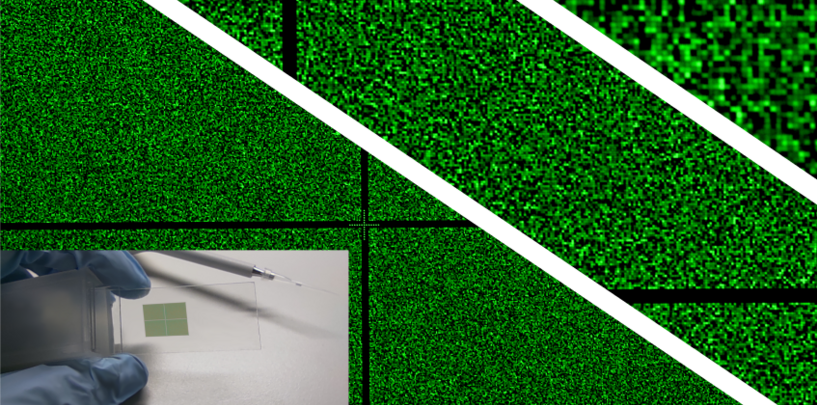A multinational research team under the University of Vienna's direction has successfully created new RNA building blocks that exhibit increased photosensitivity and chemical reactivity. In biotechnological and medical research, RNA chips can be produced much faster as a result of this.
 A full-size, high-density RNA microchip is about the size of a fingernail and can contain up to 780 000 unique RNA sequences, each occupying a ~14 × 14 μm² area. The presence and the quality of the RNA can be verified via the addition of a complementary DNA strand with a green fluorescent tag. Image Credit: C: Tadika Kekić
A full-size, high-density RNA microchip is about the size of a fingernail and can contain up to 780 000 unique RNA sequences, each occupying a ~14 × 14 μm² area. The presence and the quality of the RNA can be verified via the addition of a complementary DNA strand with a green fluorescent tag. Image Credit: C: Tadika Kekić
These chips are now produced twice as quickly and seven times more efficient in chemical synthesis. The research findings were published in the journal Science Advances.
The RNA molecule has gained attention from the public due to the development and approval of RNA-based medical products, such as mRNA vaccines, during the COVID-19 pandemic. RNA, or ribonucleic acid, is a polymer that carries information and is composed of similar subunits, but it has a far wider range of structural and functional variations than DNA.
A technique for the chemical synthesis of DNA and RNA was developed about 40 years ago. Phosphoramidite chemistry allows any sequence to be assembled from DNA or RNA building blocks.
Phosphoramidites are unique chemical building blocks that are used step-by-step in the assembly of a nucleic acid chain. Chemical "protecting groups" are carried by each building block, ensuring that the nucleic acid chain forms a natural link and preventing undesirable reactions.
Overcoming Challenges
Millions of distinct sequences can be synthesized and analyzed concurrently using this chemical process in the creation of microchips or microarrays using a solid surface the size of a fingernail. Although DNA microarrays are currently in widespread use, the lower stability of RNA has made it challenging to adapt the technology to RNA microarrays.
The production of high-density RNA chips via photolithography was demonstrated in 2018 by the University of Vienna. This process involves precisely positioning a light beam to prepare surfaces for the attachment of subsequent building blocks via a photochemical reaction. Despite this first report being a world-first and still unmatched, long production times, low yields and poor stability plagued the method. Now, this strategy has been significantly enhanced.
Development of a New Generation of RNA Building Blocks
Recently, a team from the Max Mousseron Institute for Biomolecules at the University of Montpellier (France) and the Institute of Inorganic Chemistry at the University of Vienna developed a new version of RNA building blocks with increased chemical reactivity and photosensitivity.
This breakthrough makes synthesis twice as quick and seven times more efficient by drastically cutting the time needed to produce RNA chips. With the help of these novel RNA chips, millions of candidate RNAs can be screened to find important sequences for various uses.
Making RNA microarrays containing functional RNA molecules was simply out of reach with our earlier setup, but it is now a reality with this improved process using the propionyloxymethyl (PrOM) protecting group.”
Jory Lietard, Assistant Professor, Institute of Inorganic Chemistry, Universität Wien
The article includes a study of RNA aptamers, tiny oligonucleotides that specifically bind to a target molecule. This research is a direct application of these improved RNA chips. Thousands of variations of two "light-up" aptamers—aptamers that undergo fluorescence when bound to a dye—were created on the chip. All variants can be studied simultaneously with just one binding experiment, paving the way for the development of more effective aptamers with superior diagnostic capabilities.
High-quality RNA chips could be especially valuable in the rapidly growing field of non-invasive molecular diagnostics. New and improved RNA aptamers are critically sought after, such as those that can track hormone levels in real-time or monitor other biological markers directly from sweat or saliva.”
Tadija Kekić, PhD Candidate, Universität Wien
Source:
Journal reference:
Kekić, T., et al. (2024) Accelerated, high-quality photolithographic synthesis of RNA microarrays in situ. Science Advances. doi.org/10.1126/sciadv.ado6762